
Gait :- A full repeat of the
Draft in the
Heald Shaft or
Jacquard Harness.
Gait up :- A general term used to describe
Looming-up.
[1880-1965] Daughter of
Theodore Senior Gardiner and
Lucy Georgina (neé Holdsworth)
John Holdsworth’s great-grand-daughter.
Born 21 May 1880 in district of Newington, Edinburgh. (Statutory Births 685/05 0736 p.246)
In 1881 according to census, aged 10 months, Lucy Georgina Gardiner was living with parents at 13 Hartington Gardens, Edinburgh.
Also in the house, Wilhelmina C Wilson, sister-in-law aged 22, born ca. 1859 in Camberwell, London.
Lucy Georgina Gardiner married George Herbert Hind Manfield (who was aged 35), a doctor, on 14 Oct 1912. Son of William Manfield, deceased, at St. Paul’s Cambridge.
The ceremony conducted by
Rev. Arthur John Groom, rector of Ashwicken, Norfolk, her aunt
Fanny’s husband.
Lucy Georgina Manfield died on 9th September 1965 at Fairfield, Wellin Lane, Edwalton, West Bridgford, Nottinghamshire aged 85. [Basford, 3c 33]
Lucy's mother (née Lucy Georgina Holdsworth) was living separately from Theodore in Newcastle-under-Lyme by the mid 1890's. In the 1901 census she is listed as "living on her own means". She had the children of the marriage with her. Chris Davidson has a letter from someone else in the Gardiner family which clearly states that no-one (in the Gardiner family) had any idea of her whereabouts. The hypothesis is that in some way or other, she was being supported by member(s) of her own family - the Holdsworths. She is unlikely to have been supported by Theodore since he had been made bankrupt on more than one occasion. Cecil Senior Gardiner, (born in 1888) who was Lucy's youngest son, is listed in his obituary as having gone to Uppingham School. Chris Davidson obtained the Uppingham Register, but Cecil is not listed anywhere, so the obituary may be wrong. However, there seems to have been a tradition of members of the Holdsworth family going to Uppingham. There was definitely contact between Cecil and the Holdsworth's, since in the 1911 census, (by which time his mother had died) he was listed (aged 22 years) as staying with George Bertram Holdsworth, Constance Gertrude and Hugh Reginald at Shaw Lodge, Halifax. He had already by then been to Canada to try his hand at farming. Some time later he went off to Africa, where he served in the British South African Police in what was then Rhodesia, dying quite young in 1927. [Chris Davidson, Theodore Senior Gardiner's great grandson]
Anecdotes:
Lucy Georgina Gardiner, John Holdsworth’s great-grand-daughter, married George Manfield, a doctor. See
marriage certificate.
There is reason to believe that when she died she was estranged from her husband George.
George Manfield was the doctor who attended the Bagguley mother and daughter and other members of the
care home run by 'Nurse' Dorothea Waddingham, who was hanged for the murder of the Bagguley daughter.
George was one of the chief witnesses at the inquest and subsequent trial.
[1847-1909] Son of Rev. Alexander Gardiner, Rector of Wixoe, on the Essex border in Suffolk.
Born ca. 1847 in Dublin, Ireland.
Married
Lucy Georgina Holdsworth 6 October 1879 in Halifax, Yorks.
Died Jan-Mar 1909 aged 62 Godstone, Surrey 2a 190
Occupation: Surgeon.
The Heald Shafts complete with Healds. (In the context "Equipment".)
1. Any textile material used as part of a civil engineering structure.
2. A fabric manufactured from synthetic fiber that is designed to achieve specific engineering objectives, including seepage control, media separation (eg, between sand and soil), filtration, or the protection of other construction elements such as geomembranes.
In the 1980's, following on from the previous agency run by
Carl P. Wang,
John Holdsworth & Co Ltd appointed a new Scandinavian agency with
Georges Gheysen in Copenhagen, operating under the name
Holdsworth Scandinavia Ltd.
Georges and his wife Lisbet made regular visits to the head office at
Shaw Lodge Mills, Halifax.
A drafting machine used in worsted spinning, in which the fibres in a sliver are aligned and controlled using pins on moving bars. Extremely noisy machines. This was the first stage of drawing carried out at John Holdsworth & Co Ltd in the Spinning Department, before it was closed in 1979.
Another way of describing the Sley.
Whichever way you like to spell it, greige cloth is part-processed, loom state or not yet Finished. In piece-dyed cloths it is before dyeing.
A Piece of fabric straight from the Loom. (A term mainly used in Worsted Weaving.)
John Holdsworth & Company exhibited at the Great Exhibition, where they showed their damasks, and were awarded a certificate signed by Prince Albert, which hangs in their design studio to this day. Also exhibiting were Ackroyd & Son and McCrea.
Prince Albert, Henry Cole and Joseph Paxton were the main people behind the Exhibition and largely responsible for its great success.
Joseph Paxton’s Crystal Palace in London’s Hyde Park - paid for by public subscription and built in just three months - was 1,848 feet long, 408 feet broad and 65 feet high, with 293,655 panes of glass supported by 330 iron columns and 2,300 girders. Unlike the Millennium Dome, the Great Exhibition was universally saluted.
The opening of the Great Exhibition in May 1851 was an event that, according to people who attended both, outshone Queen Victoria’s coronation. This was the zenith of the British Empire and Britain’s great exhibition was international with foreign exhibits accounting for about half the exhibition space.
More than six million people visited the exhibition, and had their eyes dazzled by over thirteen thousand exhibits from all over the world.
The real driving force behind the Great Exhibition of 1851 was Henry Cole, an assistant-keeper at the Public Records Office. Cole helped organise the Records Office after fire had burned down the old Parliament buildings.
Paxton, a gardener’s son, was employed at age 23 as gardener by the 6th Duke of Devonshire. He became known as the designer of the Crystal Palace for which he was knighted. Later he became a Member of Parliament.
The exhibition emerged from the Society for the Encouragement of Arts, Manufactures, and Commerce. The Society elected Cole to their council in 1846 and a delegation including Cole went to Prince Albert to seek his support. Albert agreed to become President of the Society and in 1847 a royal charter was granted and it became the Royal Society for the Encouragement of Arts, Manufactures and Commerce.
Through efforts of Albert and Cole, a successful Exhibition of Art Manufactures was held in 1847. An enlarged version in 1848 and 1949 were all successful. Society representatives Cole, Fuller and Wyatt visited the 1949 11th quinquennial Paris Exhibition and were disappointed to find out from the French minister that foreign countries were not present. Already involved in planning the 1850, and 1851 Society of Arts exhibitions Cole saw a need for an international exhibition. New French processes like the Jacquard loom which was exhibited in Paris could be adapted later to other materials and Cole saw the need to make industry aware of progress elsewhere. After meeting Cole, Albert announces ‘The Exhibition shall be a large one embracing foreign productions’ and a Royal Commission is proclaimed to do this. Albert risks his reputation by backing this international exhibition. “it cannot fail to soften, if not eradicate altogether, the prejudices and animosities which have so long retarded the happiness of nations” dreams Albert as he talks of a peace-festival.
9 May 1833 - 5 Nov 1884. Married
William Irving Holdsworth at St. Martin-in-the-Fields, London in 1874.
Interred interred in the family vault at
All Saints’ Church, Salterhebble, Halifax.
"Mary Holdsworth wife of W I Holdsworth was Born 9th May 1833. Died at
Shaw Lodge November 5th 1884 Wednesday morning at 7.20, and was interred in the family vault at
All Saints’ Church, Salterhebble." [Family bible record]
The Griffe (rhymes with knife) is a part of the Jacquard mechanism that lifts the hooks, and therefore the Jacquard Harness in order to form the Shed.
[b. 1884, d. 1947], Arthur Holdsworth-Groom (son of Arthur John Groom and
Fanny Holdsworth,
Clement Holdsworth’s sister) and before the First World War he had been a colonial civil servant in Nigeria.
He married Dorothy Janet Hooper, daughter of Alfred Hooper and Helen Louisa Giles.
Children of Arthur Holdsworth Groom and Dorothy Janet Hooper are:
1. John Holdsworth Groom, b. 1919, d. 1991.
2. Joan Mary Groom, b. 1917, d. 2002.
Arthur Holdsworth-Groom joined the family business of
John Holdsworth & Company at the end of the First World War and became a director upon the formation of the company in 1922.
Clement relied for the day-to-day management of the business upon his cousin, Arthur Holdsworth Groom, and the company secretary, Herbert Jackson.
Arthur changed his name from Groom to Holdsworth-Groom, by deed poll, perhaps to get a ‘handle’ on the business.
He became chairman of
John Holdsworth & Company Ltd before the succession of
William Holdsworth.
Arthur was godfather to
Anne Doyne Holdsworth, youngest daughter of
Hugh Reginald Holdsworth.
In 1932, at the time of Mabel's death, he was residing at 3 Whinney Field, Halifax. He was an executor her will, together with her husband
George and
Herbert Jackson.
Publications:
The Main Characteristics of the "Inland" Igbirras in Kabba Province, Northern Nigeria [ A. Holdsworth Groom ]
Journal of the Royal African Society, Vol. 9, No. 34 (Jan., 1910), pp. 176-183 (article consists of 8 pages)
Published by: Oxford University Press on behalf of The Royal African Society.
[ca. 1854 - ????] Son of John Groom of
Ashwicken Hall, Norfolk. (Aged 38 at time of 1891 census.)
Rector of All Saints’ Church, Ashwicken.
Married
Fanny Holdsworth on 23 April 1878.
Ashwicken Hall was demolished ca.1935.
Note: Rev. Arthur John Groom, B.A. Trinity College, Cambridge, was the rector of All Saints Church in the village of Ashwicken,
a small parish having only 94 inhabitants in 1881, living in 22 houses, and 1282 acres of land.
John Groom Esq., the lord of the manor, owns about 500 acres of land, and the Hall, a large brick mansion formerly surrounded by a moat, where he resides; and the rest of the parish belongs to his son,
Captain J. E. Groom, of Great Walsingham.
(William White’s History, Gazetteer, and Directory of Norfolk 1883)
John E Groom of Ashwicken Hall is recorded as a breeder of Jersey cattle in an 1880 register.
[ca. 1847 - 1931] Son of John Groom of
Ashwicken Hall, Norfolk.
John Edmund Groom (son of John Groom and Celia Cooper) was born 1847, and died 1931. He married (1) Annie Bayes on 16 September 1880. He married (2) Sophie.
Burial: Ashwicken.
Children of John Edmund Groom and Annie Bayes are:
1. Dorthy Groom.
2. Molly Groom.
Children of John Edmund Groom and Sophie are:
1. Alice Groom.
The following information has been kindly provided by Robert Waite of FreeREG
On 16 Sept 1880
John Edmund Groom marries an Anna Bayes in St Mary's church in Little Walsingham.
John Edmund GROOM (gentleman) marries Anna BAYES (daughter of a Surgeon)
Fathers were John Groom (gentleman) and Frederick William BAYES (surgeon)
Officiating Ministers (3 of them!) Rev. Arthur John Groom Rector of Ashwicken (Hall), W Martins vicar of St Mary's and J S Silator (we think) Curate.
Witnesses were the 2 fathers plus, we think, L Bayes, G A Raikes, J M Vincent, W H Thomas, Emily Lee Warner (Family lived in Dereham?),
Walter Holdsworth plus one Stanley Lightgood.
Son of John Groom of Ashwicken Hall, Norfolk.
Married Gertrude Holdsworth on 24 June 1879.
Jean Güsken, Textilmaschinen 1874 - 1987. (Güsken, Guesken, Gusken)
The firm of
Jean Güsken, who had their factory in Dülken, West Germany, were
loom manufacturers from 1874 until 1987.
Jean Güsken supplied many of the looms used at
John Holdsworth & Company.
Face-to-Face Looms, made in Keighley, West Yorkshire, by “Hattersley” were a close copy of the Güsken looms, copied from the company’s drawings which were obtained after the second world war. Although looms and spare parts were supplied to
Holdsworth's by Hattersley's, they were never up to the same standard as those supplied originally from Germany.
During the 1960's ten Güsken Tissomat looms were installed at
Shaw Lodge Mills for production of flat upholstery fabrics supplied to the domestic furnishing trade; these had programmed weft selection; four of the looms were fitted with jacquards, and they all ran at about 120 picks per minute. One operative could manage to look after the ten looms.
Twelve new jacquard plush looms installed at
Shaw Lodge Mills in the early 1980's came from the Güsken factory in Dülken; these were the model GMV 82. More looms were installed in the following years, including 8 dobby plush looms, model GMV 90.
In 1987 the firm of Jean Güsken was sold to another German textile machinery maker from the spinning side of the industry.
The loom types used at Holdsworths were GMV 80, GMV 82 and GMV90.
Güsken also made sectional warping machines, although these were not used by John Holdsworths.
John Holdsworth & Company's contact was Mr. Hans Josef Jansen; the managing director was Hermann Gerstein and the engineer was Kurt Eickes.
Wilhelm Busches was the production/works director.
Willy Schnatwinkel was Anwendungstechnik. (Head of application engineering.)
Herr Giebmanns was the technical head who worked closely with Kurt Eickes.
|
|
||||
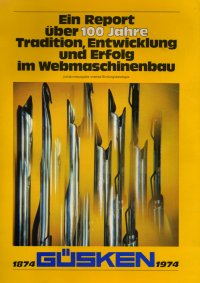
|
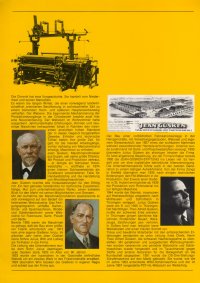
|
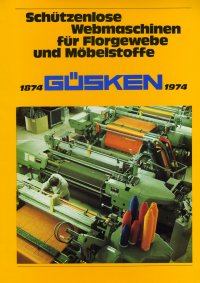
|
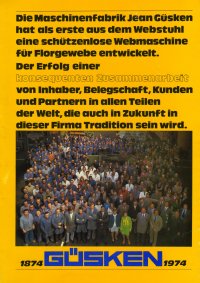
|
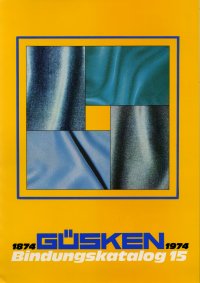
|
Gwynreta, a 26 tons motor launch, was built in 1945 for service as a torpedo recovery launch in the East, 60ft. in length.
She was never on active service and was bought by
Mr. William Holdsworth in September 1950 from Mr. G. Sleights of Grimsby.
In September and October 1950 Mr. Holdsworth took her for a trip round the English and Scottish coast and had only two fine days, at Torquay.
With a speed of 12 knots, she had triple screws, 3 Perkins 100 horsepower diesel engines and was fitted with an awning for hot weather.
She was normally berthed at Scarborough.
In September and October 1950 Mr. Holdsworth took her for a trip round the English and Scottish coast, and ran into bad weather most of the way with only two fine days, at Torquay.
From 11 May to 11 June 1951
Mr. Holdsworth took her on a business sales tour of Copenhagen, Esbjerg, Aarhus, in Denmark, and to Sweden, Norway and Germany during which he contacted 50 customers.
During a storm near Aarhaus, half a dozen windows and port-holes were broken.
Whilst in Denmark the crew met with King Frederick and the Danish royal family.
From 14 June to 5 July 1952
Mr. Holdsworth took her on a second business sales tour of Scandinavia.
Whilst entering Copenhagen, the vessel encountered the Danish Royal Yacht and received a salute from King Frederick who happened to be aboard.
During a fierce storm in the North Sea on the return journey, Gwynreta's stern rails were damaged and the motor dinghy torn from its davits and swept overboard by the rough seas.
In May 1953
Mr. Holdsworth took her to London, during the BIF where she was used as a floating sgowroom, anchored in the Thames.
|
©
2026
David W. Holdsworth |
|
Please send questions, updates, additions to: |